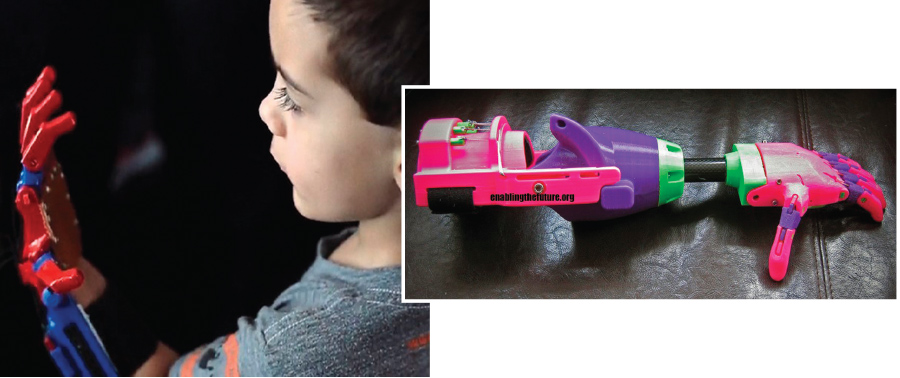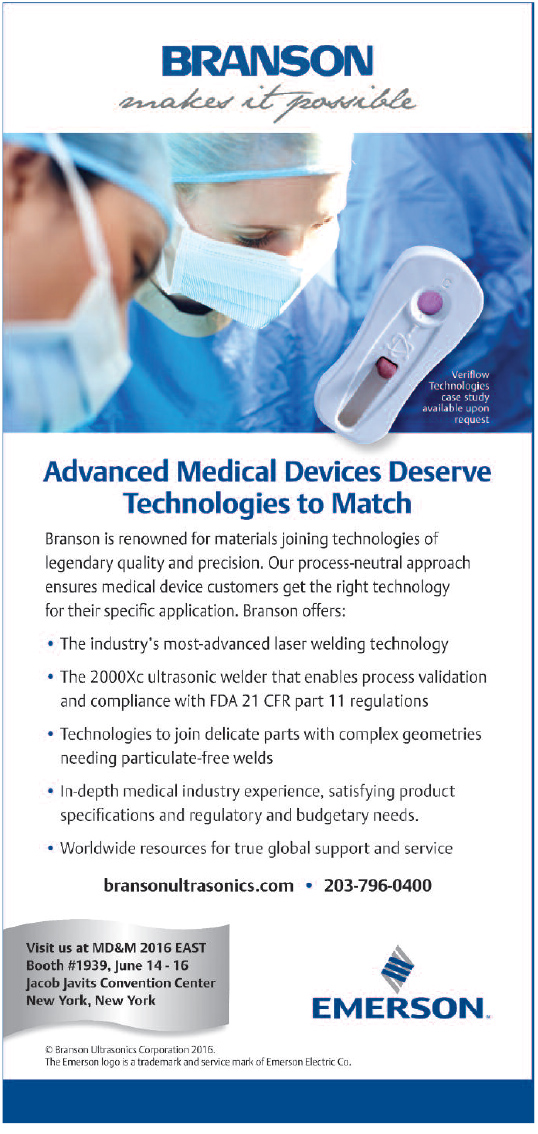Transforming Lives with 3-D Printing
Customized prosthetics, stents, and splints are allowing the children who need them to live full and healthy lives
Previous Article Next Article
By Jon Evans
Transforming Lives with 3-D Printing
Customized prosthetics, stents, and splints are allowing the children who need them to live full and healthy lives
Previous Article Next Article
By Jon Evans
Transforming Lives with 3-D Printing
Customized prosthetics, stents, and splints are allowing the children who need them to live full and healthy lives
Previous Article Next Article
By Jon Evans

Kaiba Gionfriddo is one of the children who’s received a 3-D printed splint to prevent his windpipe from collapsing (photo courtesy of Univ. of Michigan Health System, Dept. of Communication).

The 3-D printed prosthetic hands of the e-NABLE initiative are specifically designed for children, who regularly need to replace their prosthetic hands as they grow (photos courtesy of Autodesk).

The 3-D printed prosthetic hands of the e-NABLE initiative are specifically designed for children, who regularly need to replace their prosthetic hands as they grow (photos courtesy of Autodesk).

These Autodesk photos show how e-NABLE hands are composed of several printed components.

These Autodesk photos show how e-NABLE hands are composed of several printed components.
Pediatric tracheobronchomalacia (TBM) is a life-threatening condition that affects young children, in which their windpipe periodically collapses, preventing normal breathing. The condition usually resolves itself as the child grows and the windpipe becomes thicker and stronger, but until then the child faces a serious risk of dying, especially in severe cases. Although there are treatments based on strengthening the windpipe with devices such as stents, they are prone to failure.
Now, however, 3-D printing may offer a lifeline. In a paper last year in Science Translational Medicine, a team of U.S. researchers led by Glenn Green at the University of Michigan in Ann Arbor reported using 3-D printing to produce a plastic splint for keeping the windpipe intact. When tested in three children with pediatric TBM aged between three and 16 months, the splints successfully prevented their windpipes from collapsing without any complications. Several years on and the children remain perfectly healthy.
The splint comprises a thin, flexible open tube attached to the outside of the windpipe to provide support. Its flexibility allows the tube to stretch with the growing windpipe. It’s also made from the biodegradable polyester polycaprolactone, which means that the child’s body gradually absorbs the device in around three years. So the device naturally disappears as the windpipe becomes strong enough to support itself, rather than having to be removed in a surgical procedure.
The great benefit of 3-D printing is that it allowed Green and his colleagues to produce stents specifically designed for each child’s windpipe, based on a computed tomography (CT) scan of the windpipe, greatly reducing the chance of failure. “These cases broke new ground for us because we were able to use 3-D printing to design a device that successfully restored patients’ breathing through a procedure that had never been done before,” says Green.
Following the success of this initial small-scale test, Green and his colleagues plan to conduct a proper clinical trial for 30 patients with the same condition. They’ve already licensed the technique to Materialise, a Belgian 3-D printing company that produced the software tools that Green and his colleagues used to design the splints, and have also improved the design and printing process.
“We have continued to evolve and automate the design process for the splints, allowing us to achieve in two days what used to take us up to five days to accomplish,” says team member Scott Hollister, also at the University of Michigan.
3-D Printing’s Evolution in Healthcare
Healthcare has long taken advantage of 3-D printing: one of the first practical applications involved printing hearing aids designed to fit the specific shape of a patient’s ear. As 3-D printing has evolved and developed over the years, however (such that the term now covers various different techniques for building up 3-D structures by depositing successive layers of materials such as plastics, metals, and ceramics), it’s being successfully applied to more and more medical problems.
One particularly fruitful area involves printing implants to replace missing sections of bone. Because such implants need to be strong, they tend to be produced from metals such as titanium using a technique called laser sintering, which involves depositing layers of metal powder that are then solidified by heat from a laser. As with the windpipe splint, this usually involves producing images of the bone with techniques such as CT scanning, magnetic resonance imaging (MRI), and ultrasound, in order to ensure the implant is just the right shape to replace the missing section. So far, this approach has been used to produce printed versions of various parts of the skeleton, including vertebrae, ribs, hips, and sections of skull.
For other parts of the body, plastic is the preferred material, especially as the range of plastics that can be used for 3-D printing is growing all the time, offering materials with a range of different physical properties. This printing process tends to involve depositing layers of liquid plastic, which are either solidified by irradiating them with ultraviolet light or, if they are thermoplastics, by simply allowing them to cool.
New Windpipes
So as well as helping to support windpipes, 3-D printing is also being used to create new windpipes, in order to repair or replace ones damaged by injury or diseases such as cancer.
Todd Goldstein and his colleagues at the Feinstein Institute for Medical Research in New York have printed windpipe scaffolds using the bioplastic polylactic acid (PLA), which is one of the most popular plastics for 3-D printing and also a widely used material for surgical implants. They then inoculated these PLA scaffolds with a mixture of cells known as chondrocytes and the fibrous protein collagen, which together create cartilage in the shape of a replacement windpipe.
“Making a windpipe or trachea is uncharted territory,” says Goldstein. “It has to be rigid enough to withstand coughs, sneezes, and other shifts in pressure, yet flexible enough to allow the neck to move freely. With 3-D printing, we were able to construct 3-D-printed scaffolding that the surgeons could immediately examine, and then we could work together in real time to modify the designs.”
Goldstein and his colleagues actually employed two 3-D printers, using the first to print the components required for adapting a second 3-D printer—so that they could print the PLA from one extruder and the mixture of chondrocytes and collagen from the other printer. The mixture is printed as a liquid, filling the gaps in the PLA scaffolding before heat from the printing process converts it into a gel. In this way, a two inch-long (51-mm) section of windpipe can be printed in less than two hours, after which it is placed in a bioreactor that gently heats the scaffold over a period of four weeks to encourage the chondrocytes to grow and produce collagen.
And like the splint for strengthening windpipes, this approach could prove particularly useful for treating young children. “There’s really a limitless number of sizes and permutations you might need to reconstruct an airway in a child,” says Lee Smith from Cohen’s Children’s Medical Center in New York, who originally asked Goldstein about the possibility of printing an artificial windpipe.
Printed Eardrums
A similar approach of combining a printed scaffold with biological material has been taken by a team of researchers from Italy and the Netherlands to produce an artificial eardrum. As reported in a paper in Biofabrication, they made the scaffold from the copolymer poly(ethylene oxide terephthalate)/poly(butylene terephthalate) (PEOT/PBT), which has already been approved for biomedical applications by the U.S. Food and Drug Administration.
Eardrums are tough, thin membranes made from precisely-aligned collagen fibers. So to produce an artificial version, the researchers combined 3-D printing with electrospinning, in which fibers of the copolymer are drawn out of a liquid using an electrical charge. This allowed them to produce a scaffold that replicated the size and structure of a normal human eardrum, with a diameter of 15 mm and a thickness of around 100 µm. They then inoculated this scaffold with living cells that can produce collagen, showing that the cells were able to grow perfectly well on the scaffold.
Such artificial eardrums could be used to replace or repair eardrums that have become perforated through injury or disease, which again is particularly prevalent in young children. Current methods for repairing eardrums use tissue taken from other parts of the body. But this tissue lacks the specific structure found in eardrums, limiting its acoustic performance—whereas the artificial eardrums should be a much closer match.
Enabled Hands
In addition to being able to produce medical devices specifically designed for individuals, 3-D printing can also produce certain medical devices much more cheaply, allowing them to be used by a much greater range of patients.
Inspired by this idea, several research groups and companies are now using 3-D printing to produce prosthetic hands. Until recently, such prosthetic hands have either been simple and inexpensive, such as metal hooks, or advanced and expensive, with even basic muscle-actuated hands costing around $10,000. Using 3-D printing, a new British company called Open Bionics can now produce an artificial hand made from plastics such as PLA for less than £1000 (~$1430). Despite their low cost, these printed hands are able to replicate the functionality of advanced prosthetics, including individual finger movement via sensors stuck to the skin.
Even these prosthetic hands are expensive compared to those produced by a U.S. initiative called e-NABLE, which is offering prosthetic hands for free. These hands are specifically designed for children, who regularly need to replace their prosthetic hands as they grow, preventing many from being able to afford advanced, robotic versions.
E-NABLE is a worldwide network of people who own 3-D printers and voluntarily produce hands-to-order based on open-source designs that can be downloaded from a central website. These hands are also produced from PLA, but are less sophisticated than those produced by Open Bionics. Nevertheless, the hand can still be opened or closed by flexing the wrist or elbow, depending on where the hand is attached to the child’s arm. This means it can be used for holding a baseball bat or moving handlebars while riding a bicycle. The hands are also designed specifically for each child, often using a plaster cast of the child’s arm.
Founded in 2013, e-NABLE has so far produced around 1500 prosthetic hands, but it’s expanding all the time. Recently, it joined forces with the U.S. software company Autodesk, which is supporting e-NABLE’s efforts by providing access to its 3-D CAD software for mechanical design. This will help
e-NABLE to develop a whole new generation of 3-D printed prosthetics.
Through these kinds of developments, 3-D printing is beginning to transform the lives of many different patients, both inside and out.
